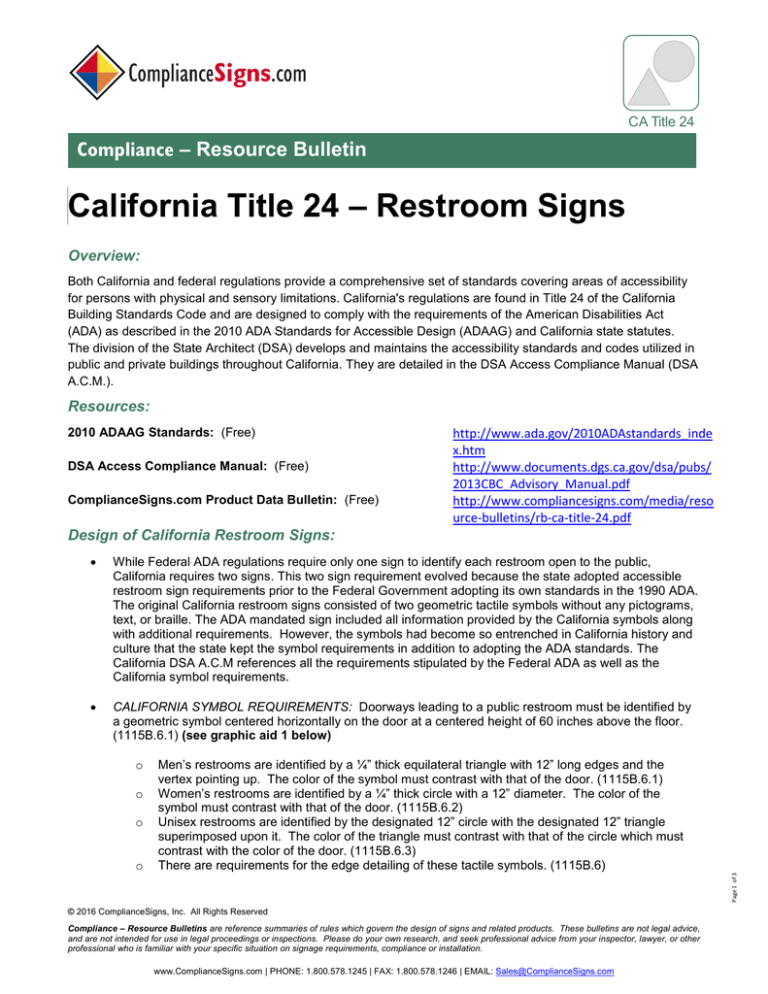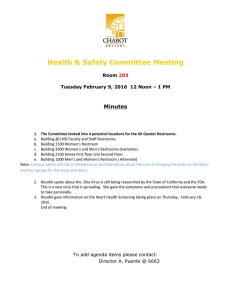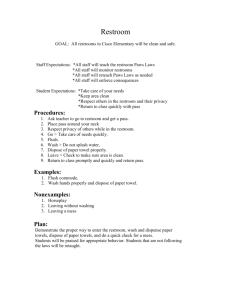
CA Title 24
Compliance – Resource Bulletin
California Title 24 – Restroom Signs
Overview:
Both California and federal regulations provide a comprehensive set of standards covering areas of accessibility
for persons with physical and sensory limitations. California's regulations are found in Title 24 of the California
Building Standards Code and are designed to comply with the requirements of the American Disabilities Act
(ADA) as described in the 2010 ADA Standards for Accessible Design (ADAAG) and California state statutes.
The division of the State Architect (DSA) develops and maintains the accessibility standards and codes utilized in
public and private buildings throughout California. They are detailed in the DSA Access Compliance Manual (DSA
A.C.M.).
Resources:
2010 ADAAG Standards: (Free)
DSA Access Compliance Manual: (Free)
ComplianceSigns.com Product Data Bulletin: (Free)
http://www.ada.gov/2010ADAstandards_inde
x.htm
http://www.documents.dgs.ca.gov/dsa/pubs/
2013CBC_Advisory_Manual.pdf
http://www.compliancesigns.com/media/reso
urce-bulletins/rb-ca-title-24.pdf
Design of California Restroom Signs:
While Federal ADA regulations require only one sign to identify each restroom open to the public,
California requires two signs. This two sign requirement evolved because the state adopted accessible
restroom sign requirements prior to the Federal Government adopting its own standards in the 1990 ADA.
The original California restroom signs consisted of two geometric tactile symbols without any pictograms,
text, or braille. The ADA mandated sign included all information provided by the California symbols along
with additional requirements. However, the symbols had become so entrenched in California history and
culture that the state kept the symbol requirements in addition to adopting the ADA standards. The
California DSA A.C.M references all the requirements stipulated by the Federal ADA as well as the
California symbol requirements.
CALIFORNIA SYMBOL REQUIREMENTS: Doorways leading to a public restroom must be identified by
a geometric symbol centered horizontally on the door at a centered height of 60 inches above the floor.
(1115B.6.1) (see graphic aid 1 below)
o
o
o
Page 1 of 3
o
Men’s restrooms are identified by a ¼” thick equilateral triangle with 12” long edges and the
vertex pointing up. The color of the symbol must contrast with that of the door. (1115B.6.1)
Women’s restrooms are identified by a ¼” thick circle with a 12” diameter. The color of the
symbol must contrast with that of the door. (1115B.6.2)
Unisex restrooms are identified by the designated 12” circle with the designated 12” triangle
superimposed upon it. The color of the triangle must contrast with that of the circle which must
contrast with the color of the door. (1115B.6.3)
There are requirements for the edge detailing of these tactile symbols. (1115B.6)
© 2016 ComplianceSigns, Inc. All Rights Reserved
Compliance – Resource Bulletins are reference summaries of rules which govern the design of signs and related products. These bulletins are not legal advice,
and are not intended for use in legal proceedings or inspections. Please do your own research, and seek professional advice from your inspector, lawyer, or other
professional who is familiar with your specific situation on signage requirements, compliance or installation.
www.ComplianceSigns.com | PHONE: 1.800.578.1245 | FAX: 1.800.578.1246 | EMAIL: Sales@ComplianceSigns.com
CA Title 24
Compliance – Resource Bulletin
(California Restroom Signs Continued)
Though permitted and often included, there is no requirement for providing gender pictograms or
the international symbol of accessibility on the geometric symbols. The inclusion of these
additional features is open to interpretation by local code officials who should be consulted for a
final determination.
Graphic Aid 1:
FEDERAL ADAAG SIGN REQUIREMENTS: One concern the authors of the ADA had with the California
door symbols was the possibility that a visually impaired person using the symbol’s tactile feature to read
the symbol while standing in front of a restroom door could be injured by someone suddenly opening the
door. This prompted the requirement that a separate sign with tactile text and braille designating
restrooms be placed on the wall adjacent to the doorway. This sign consists of the following elements:
(see graphic aid 2 below)
Page 2 of 3
Tactile text designating the gender access to the restroom (men, women, restroom {if unisex},
family, etc.) with the exact braille translation of the text directly below. The braille must be
contracted (grade 2) with California spacing and domed raised dots. There are also
specifications for the size, style, and spacing of the tactile text. (DSA A.C.M. 1117B.5.1-6)
Though not required, it is very common for a pictogram depicting the gender access to be
included on the sign. If the restroom is accessible, the sign must also include the international
symbol of accessibility (ISA). Pictograms and symbols are placed in a pictogram field, 6” high, at
the top of the sign followed by the tactile text and braille directly below. The symbol or pictogram
is often tactile, though not required to be, and should not be described in braille. (DSA A.C.M.
1117B.5.1.3; 1117B.5.5.3; 1117B.5.8)
© 2016 ComplianceSigns, Inc. All Rights Reserved
Compliance – Resource Bulletins are reference summaries of rules which govern the design of signs and related products. These bulletins are not legal advice,
and are not intended for use in legal proceedings or inspections. Please do your own research, and seek professional advice from your inspector, lawyer, or other
professional who is familiar with your specific situation on signage requirements, compliance or installation.
www.ComplianceSigns.com | PHONE: 1.800.578.1245 | FAX: 1.800.578.1246 | EMAIL: Sales@ComplianceSigns.com
CA Title 24
Compliance – Resource Bulletin
(California Restroom Signs Continued)
Graphic Aid 2:
SIGN LOCATION & INSTALLATION: California’s requirement that two signs must identify each restroom
makes it essential that their installation follow the specifications in the standard. The California geometric
door symbol must be centered horizontally on the door at a height of 60 inches above the floor to the
center of the symbol. (1115B.6.1) The Federal ADAAG sign with the tactile text, braille, and possible
visual features must be mounted at a height of 60 inches above the floor to the center of the sign. The
sign should be located on the wall adjacent to the latch side of the door. Where there is no wall space on
the latch side, the sign should be placed on the nearest adjacent wall, preferably on the right. (DSA
A.C.M. 1117B.5.7) (see graphic aid 3 below)
For California Restroom Signs please visit our store: http://www.compliancesigns.com
© 2016 ComplianceSigns, Inc. All Rights Reserved
Compliance – Resource Bulletins are reference summaries of rules which govern the design of signs and related products. These bulletins are not legal advice,
and are not intended for use in legal proceedings or inspections. Please do your own research, and seek professional advice from your inspector, lawyer, or other
professional who is familiar with your specific situation on signage requirements, compliance or installation.
www.ComplianceSigns.com | PHONE: 1.800.578.1245 | FAX: 1.800.578.1246 | EMAIL: Sales@ComplianceSigns.com
Page 3 of 3
Graphic Aid 3:




